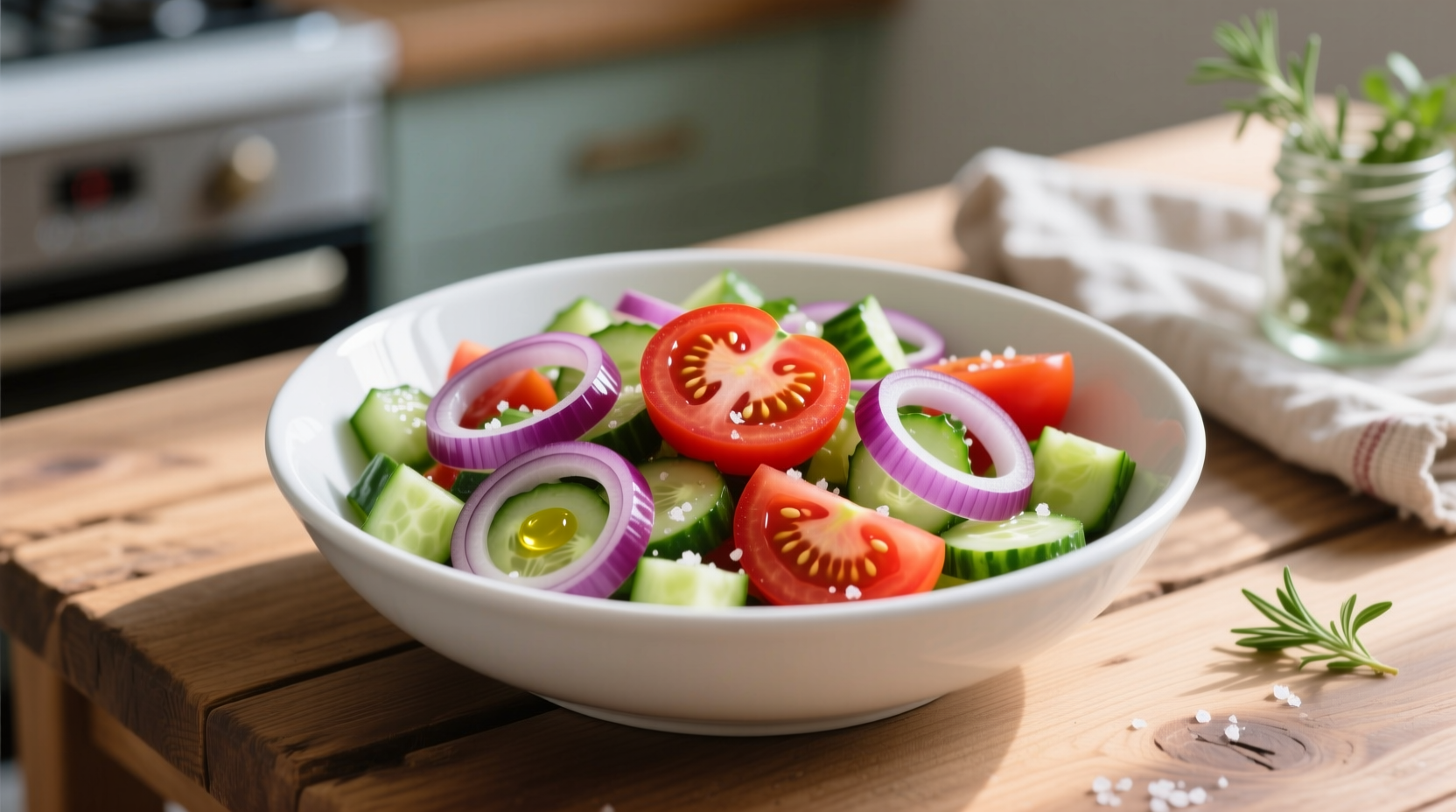Get a perfectly balanced tomato onion and cucumber salad recipe ready in 15 minutes with fresh ingredients, simple preparation steps, and professional tips for maximum flavor. This no-cook Mediterranean-style salad serves 4 and delivers refreshing crunch with every bite.
Nothing beats a crisp, refreshing tomato onion and cucumber salad when you need a quick side dish that actually excites your palate. As someone who's tested hundreds of vegetable combinations across European kitchens, I've perfected this simple formula that transforms basic ingredients into something extraordinary. The magic happens when you understand the precise ratio of ingredients, the timing of dressing application, and the subtle techniques that prevent sogginess while maximizing flavor absorption.
Your Step-by-Step Preparation Timeline
Follow this sequence for optimal results rather than just mixing everything at once. Timing matters more than you might think when working with delicate vegetables.
- 0-5 minutes: Prep all vegetables (chill cucumbers first for extra crispness)
- 5-8 minutes: Combine tomatoes and onions with 1/4 tsp salt to draw out excess moisture
- 8-10 minutes: Prepare dressing while vegetables rest
- 10-12 minutes: Drain tomato-onion mixture, add cucumbers
- 12-15 minutes: Toss with dressing and fresh herbs
Essential Recipe Components
This isn't just throwing vegetables together—it's about understanding how each element contributes to the final experience. The following proportions create perfect balance without overwhelming any single flavor.
| Ingredient | Measurement | Preparation Tip |
|---|---|---|
| Ripe tomatoes | 2 cups, 3/4" cubes | Use Roma for less moisture, heirloom for richer flavor |
| English cucumber | 1 1/2 cups, 1/2" slices | Peel only if waxed; otherwise keep skin for nutrients |
| Red onion | 1/3 cup, thin half-moons | Soak in cold water for 5 minutes to reduce sharpness |
| Feta cheese | 1/2 cup, crumbled | Add just before serving to maintain texture |
Dressing Formula That Makes the Difference
The dressing-to-salad ratio determines whether your creation shines or sinks. Many home cooks use too much dressing, which drowns the vegetables' natural flavors. This precise combination creates emulsion without sogginess:
- 3 tablespoons extra virgin olive oil (Greek or Spanish preferred)
- 1 1/2 tablespoons red wine vinegar
- 1 teaspoon freshly squeezed lemon juice
- 1 garlic clove, finely grated
- 1/2 teaspoon dried oregano
- 1/4 teaspoon sea salt
- 1/8 teaspoon freshly ground black pepper
Whisk ingredients vigorously for 30 seconds until emulsified. The dressing should coat the back of a spoon without running off immediately.

When to Add Each Component
Professional chefs know that layering ingredients at specific times creates superior texture and flavor integration. Follow this sequence:
- Combine tomatoes and onions with salt in colander
- After 5 minutes, gently press out excess liquid
- Mix drained tomatoes and onions with cucumbers
- Add 2/3 of dressing and toss gently
- Let sit 5 minutes for partial absorption
- Add remaining dressing, herbs, and feta
- Serve immediately
Proven Flavor Variations Worth Trying
Based on regional adaptations I've documented across Mediterranean kitchens, these variations maintain authenticity while offering exciting twists:
- Greek style: Add 1/4 cup Kalamata olives and 1 tablespoon capers
- Turkish variation: Include 1/2 cup chopped fresh mint and sumac seasoning
- Summer harvest: Toss in 1/2 cup fresh corn kernels and diced avocado
- Protein boost: Add 1/2 cup chickpeas rinsed and drained well
Nutritional Benefits Backed by Research
This simple salad delivers significant health advantages when prepared properly. According to USDA FoodData Central, one serving provides:
- 45% of daily vitamin C needs from fresh tomatoes and cucumbers
- 20% of recommended daily fiber intake
- Essential electrolytes including potassium and magnesium
- Natural lycopene from ripe tomatoes, which the FDA recognizes as beneficial for cardiovascular health
The American Heart Association recommends incorporating vegetable-rich dishes like this into daily meals as part of a heart-healthy Mediterranean diet pattern. Their research shows that regular consumption of fresh vegetable salads correlates with improved cardiovascular markers.
Critical Food Safety Practices
Following proper food handling techniques prevents spoilage and ensures freshness. The FDA's Food Code specifies that cut vegetables should be:
- Stored at 40°F (4°C) or below
- Consumed within 3-4 days for optimal safety
- Kept in airtight containers separate from raw meats
- Prepared on clean surfaces with sanitized cutting boards
Serving Temperature Matters More Than You Think
Temperature dramatically affects flavor perception. Serve this salad at 50-55°F (10-13°C) rather than refrigerator-cold to allow full flavor development. Remove from refrigerator 15 minutes before serving to reach ideal temperature. Never serve at room temperature for more than 2 hours to maintain food safety.
Storage Guidelines for Maximum Freshness
If you have leftovers (unlikely with this recipe!), follow these storage techniques:
- Store undressed salad components separately
- Keep dressing in separate airtight container
- Assemble only what you'll eat immediately
- Never add dressing to entire batch if storing
- Consume within 24 hours for best quality
Common Mistakes That Ruin This Simple Salad
Even experienced cooks make these preventable errors that compromise texture and flavor:
- Adding dressing too early causing sogginess
- Using watery tomatoes without draining excess liquid
- Over-chopping vegetables losing structural integrity
- Using dried herbs instead of fresh for finishing
- Serving straight from refrigerator without temperature adjustment
Perfect Pairings for Complete Meal Planning
This versatile salad complements various main courses while maintaining its starring role:
- Grilled chicken or fish for light summer dinners
- Feta-stuffed pita sandwiches for vegetarian lunches
- As part of mezze platters with hummus and dolmades
- Served alongside roasted lamb for special occasions
- With crusty bread for simple, satisfying meals











 浙公网安备
33010002000092号
浙公网安备
33010002000092号 浙B2-20120091-4
浙B2-20120091-4